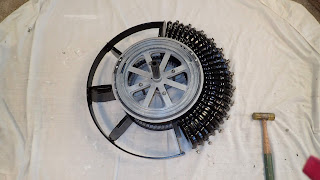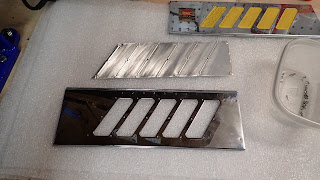Assembly of the Gripper Unit started with laying out all of the parts, with everything shown here having been previously either plated, painted, or thoroughly cleaned:
As an aside, I had previously done some assembly work on the mechanism baseplate/frame, installing the "rear frame/mount", and the Gripper Connecting Rod and reversing mechanism/lever, as seen here (rear view):
And here (front view):
The Gripper Connecting Rod needs to be installed in this opening before bolting down the Gripper Housing:
Note the Micro Switches, and spacers, have been installed as well.
Before bolting-down the Gripper Housing I temporarily installed the External Shaft to (hopefully!) ensure the opening/bearing at the "rear mount" was aligned with the Gripper Housing bearing, as even a slight misalignment could cause binding. Thankfully once I tightened things up the shaft rotated as smooth as silk!
Note that the factory did provide bolts for adjusting the height of the "rear mount" to line-up with the Gripper Housing, but (and here I am making an assumption) once they got everything lined-up they made things permanent by drilling and "pinning" the "rear mount" to the "rear frame":
My thoughts on this are that if someone were to use a Gripper Housing and "rear mount/frame" from two different units, the pins may need to be drilled-out and the openings aligned.
Moving on, the end of the Gripper Connecting Rod has two clips which connect to the Gripper Reversing Bracket Assembly:
Which mounts to the Gripper Housing by a Shoulder Bolt:
I could not find a torque, procedure, or setting, for the shoulder bolt, so I simply tightened it up until the Reversing Bracket Assembly seemed to be "too tight", and then I backed it off just a bit. Note there is an Allen-head setscrew for this bolt, and I "locked-in" the adjustment of the Shoulder Bolt with this set screw.
Keen eyes will note that the threads of this bolt appear to be somewhat stripped-out, no doubt from a previous owner or serviceman removing the bolt without knowing the setscrew was there because of layers of crud! In fact, I have three of these assemblies, and all of them have suffered the same fate. This bolt, while appearing to be stripped, was actually quite "use-able", and the best of the three that I have!
The next thing I did was to assemble the Trunnion Shaft,"Geneva Gripper Turnover" cam ("inner" cam), and Gripper Spider Assembly. The Spider Assembly is located at the top of, and in-between the "ears of, the Gripper Housing, and is shown here with "Record Playing" text. The Trunnion Shaft simply slips into the housing, and Spider Assembly, with some lube. (I'll talk more about lube at the end of this post).
Pay no attention to that "extra" cam, as I found that I was premature in installing it!
Anyway, the "inner" cam simply slides onto the Trunnion Shaft, and is connected via a pin from the Spider Assembly:
So far, so good.....
Before installing the Gripper Drive Shaft Assembly, this red washer needs to be installed....
And lubed:
Ok, here's where things get tricky, or at least they did for me!
While attempting to install the Gripper Drive Shaft Assembly I recalled that the Geneva Gripper Release cam (or "outer" cam) could not be installed previously, as the "flange" from the Drive Shaft needs to reside behind the outer Geneva cam!
(I can hear you already: "Huh?")
Here's what I'm talking about:
On the shaft "sticking out" the right side, ultimately that flange needs need located "behind" (or "inside") the outer cam, and to be precise, "below" the inner cam. And with that outer cam in place, you can't get there from here.....
So I had to remove the outer cam, slide the Drive Shaft Assembly in, make sure everything was lined-up/"clocked" correctly....
And it was only when I got to this point that I could re-install the outer cam:
For reference and/or comparison purposes only, here's the "timing" of the Geneva cams on my Parts unit:
As well as shot of the Geneva cams for the completed assembly for this unit (this picture taken way out of context/time):
I shot a quick video of what things should look like, and how it should operate at this point, and uploaded it to Youtube. It can be seen here:
https://youtu.be/g4E7AI2s5mg
Yes, that's my voice....
My advice to anyone doing this: Take your time, be patient, and don't try to "force" anything. Be aware that there is more than one way of assembling these parts, but only one way they will go together successfully! If, when operating the mechanism by hand, it doesn't seem like it's working right, it's simply not assembled correctly.
(1/16/19 Edit: I've had to remove and reinstall the Gripper Drive Assembly several times recently (reasons for which will be explained when appropriate), and I've found that I do NOT need to remove the Outer Cam gear in order to install the Gripper Drive Shaft Assembly! In fact, now that I've learned this, it's much easier to service this mechanism.)
Next I needed to install the Gripper Arm and related parts:
After applying a liberal amount of lube, I installed the Inner Gripper Casting into the arm, and installed the Gripper Arm into the Gripper Spider Assembly.
Here's a shot from the rear, before I installed the Gripper Spring:
After the Spring (not shown), the Gripper Arm Reversing Cam is installed, and everything is "locked" in place by the Drive-Loc Pin located at the end of the Inner Gripper Casting:
Here I found another "issue", that being my chrome plating was so thick that these "locating ears" of the Gripper Arm wouldn't fit the "locating boss":
I'd like to say I found an elegant solution for this, but what I eventually did was I simply filed-down these ears so that they "just fit" the boss. Why not file down the boss instead? Because I have two more Gripper Arms, and I'm not sure I'm going to use this one "long term", as I scratched-up the new chrome pretty badly in one spot. Plus, the lettering is "sunk-in" a little due to the chroming process....
Regardless, here's another video, this one showing how the Gripper Unit Assembly works:
https://youtu.be/Vz5OImgxOJ0
At this point all of the more difficult issues had been addressed, and all that was left was installation of some of the small, ancillary parts, such as the Micro Switches (new) and the Micro Safety cams (not adjusted), the Popularity Counter tab and arm, and the Gripper Drive Shaft gear:
And just for "kicks" more than anything else, I temporarily bolted-up the Gripper Motor, maybe just to see who it looked (visually) and felt (emotionally) to have that back in place:
Earlier I mentioned that I was going to discuss the lube I chose to use, and while I'm probably going to get some disagreement from people with more experience than I (you guys on the jukebox email list know I'm talking about you here!), I chose my lube based on these factors:
* Smell,
* Cleanliness (aesthetics),
* Knowing I would be servicing this unit frequently, and
* This unit is going to be buried with me!
"Normal" and /or"Rockola recommended" lube for the Gripper Unit Assembly is no longer available, and most people these days use either non-detergent, straight weight 20 oil (ND20), or some sort of graphite lube. However, oil "smells", and all of the graphite lubes I found were unsightly (brown and nasty looking).
Knowing that I'm probably going to be Servicing this unit frequently (I know I won't be able to keep my hands out of it!), and that it's "not going anywhere", I chose to use the same lube I used for the gearboxes of the Magazine and Gripper Motors:
I figure, if it's good enough to lube Industrial-Grade food blenders and what-not, while still being "slick and slippery" at room temperature, it's gotta be good enough for my lowly 1452!
That's about it for now. Some of these parts will need to be adjusted after I power-up the unit, but before I do that I want/need to install the Record Magazine assembly. Thankfully that will be a much short post...if it even deserves to be one.































































